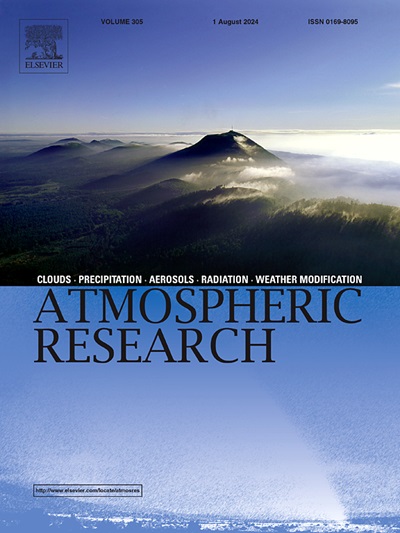Diversity of 10–20-day propagation of genesis potential index and its roles in tropical cyclogenesis over the South China Sea
IF 4.5
2区 地球科学
Q1 METEOROLOGY & ATMOSPHERIC SCIENCES
引用次数: 0
Abstract
The genesis potential index (GPI) is used to quantify the major large-scale environmental parameters associated with tropical cyclogenesis (TCG). It is demonstrated that the 10–20-day GPI dominates the intraseasonal variability of the GPI over the South China Sea (SCS) from June to September during 1979–2021. The spatiotemporal evolutions of the 10–20-day GPI in the TCG processes show distinct diverse characteristics. Through extended empirical orthogonal function (EEOF) analysis and spatial correlation coefficients, the 10–20-day GPI propagation characteristics of the TCG processes are mainly classified into 3 categories: WN-Pattern, N-Pattern, and W-Pattern. The WN-Pattern originates from the tropical western North Pacific (WNP), then gradually intensifies and propagates northwestward to the northern SCS. The N-Pattern moves northward from Indonesia to the central-northern SCS and distinctly strengthens from 2 days before the cyclogenesis. The W-Pattern features westward propagation from the subtropical WNP to the northern SCS. These three propagation patterns correspond to the respective locations of SCS TCG. In the GPI terms of these three patterns, the low-level absolute vorticity and mid-level relative humidity are considered as the dominant environmental factors. Furthermore, the significant cyclonic circulation anomalies and water vapor flux anomalies are well coordinated with the 10–20-day GPI in all the three patterns, constituting favorable dynamical and thermodynamic conditions for SCS TCG. This study may be beneficial for deeper comprehension of the subseasonal large-scale environmental factors about SCS TCG.
成因势指数 10-20 天传播的多样性及其在南海热带气旋生成中的作用
成因势指数(GPI)用于量化与热带气旋生成(TCG)相关的主要大尺度环境参数。结果表明,1979-2021 年间,10-20 天的成因位势指数在南海 6-9 月的季内变化中占主导地位。在TCG过程中,10-20天GPI的时空演变表现出明显的多样性特征。通过扩展经验正交函数(EEOF)分析和空间相关系数分析,TCG过程的10-20天GPI传播特征主要分为3类:WN模式、N模式和W模式。WN 模式发源于热带北太平洋西部,然后逐渐加强并向西北传播到南中国海北部。N 型从印度尼西亚向北移动到南中国海中北部,并在气旋生成前两天开始明显增强。W-模式的特点是从副热带的 WNP 向西传播到北部的 SCS。这三种传播模式分别对应于 SCS TCG 的位置。在这三种模式的 GPI 条件下,低层绝对涡度和中层相对湿度被认为是主导环境因素。此外,在这三种模式中,显著的气旋环流异常和水汽通量异常与 10-20 天的 GPI 协调良好,构成了 SCS TCG 的有利动力和热动力条件。该研究有助于深入理解有关 SCS TCG 的次季节大尺度环境因子。
本文章由计算机程序翻译,如有差异,请以英文原文为准。
求助全文
约1分钟内获得全文
求助全文
来源期刊

Atmospheric Research
地学-气象与大气科学
CiteScore
9.40
自引率
10.90%
发文量
460
审稿时长
47 days
期刊介绍:
The journal publishes scientific papers (research papers, review articles, letters and notes) dealing with the part of the atmosphere where meteorological events occur. Attention is given to all processes extending from the earth surface to the tropopause, but special emphasis continues to be devoted to the physics of clouds, mesoscale meteorology and air pollution, i.e. atmospheric aerosols; microphysical processes; cloud dynamics and thermodynamics; numerical simulation, climatology, climate change and weather modification.
 求助内容:
求助内容: 应助结果提醒方式:
应助结果提醒方式:


